Planes que admiten esta función: Business Enterprise
Muchas organizaciones de todo el mundo utilizan Google Docs como herramienta de gestión documental. Google, como plataforma, ofrece un entorno más integrado en el que la gestión de múltiples formas de documentos y archivos es bastante sencilla.
Integración de Google Docs con Document360
Con Document360 como plataforma de base de conocimientos, puede colaborar con varios proveedores externos que aportan contenido a través de Google Docs. Aunque Google Docs es una gran plataforma para la colaboración, la transferencia manual de estos artículos a Document360 puede llevar mucho tiempo y esfuerzo.
Al conectar Google Docs y Document360 en Zapier, puede facilitar fácilmente el flujo de contenido entre estas plataformas. Para establecer una conexión entre Google Docs y Document360, siga estos pasos:
Asegúrate de haber iniciado sesión en tu cuenta de Zapier.
En el menú de navegación de la izquierda, haga clic en Crear y, a continuación, haga clic en Zaps en las opciones disponibles.
Zap se creará con el flujo de activación y acción .

Conexión de Google Docs y Document360 en Zapier
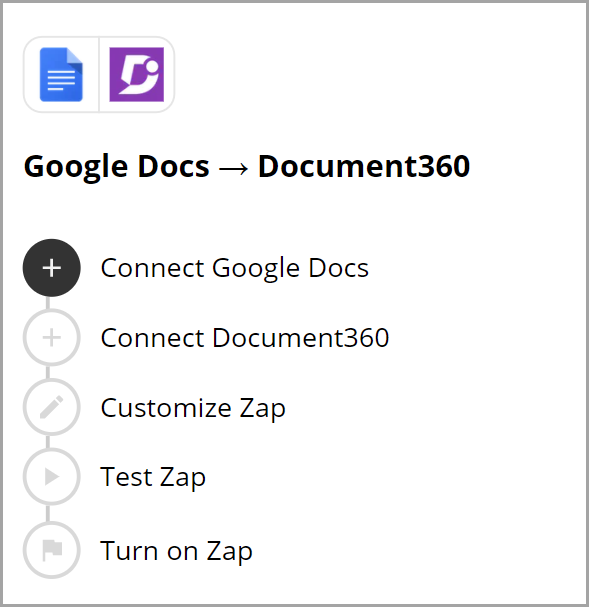
Paso 1: Conectar Google Docs
En el campo Desencadenador , elija Google Docs.
En el campo Evento desencadenador , seleccione el evento necesario para desencadenar en el Google Docs.
Si desea configurar una aplicación diferente más adelante, puede hacerlo haciendo clic en Cambiar.
Haga clic en el campo Cuenta y aparecerá un panel de inicio de sesión .
Introduzca sus credenciales de inicio de sesión y haga clic en Permitir.
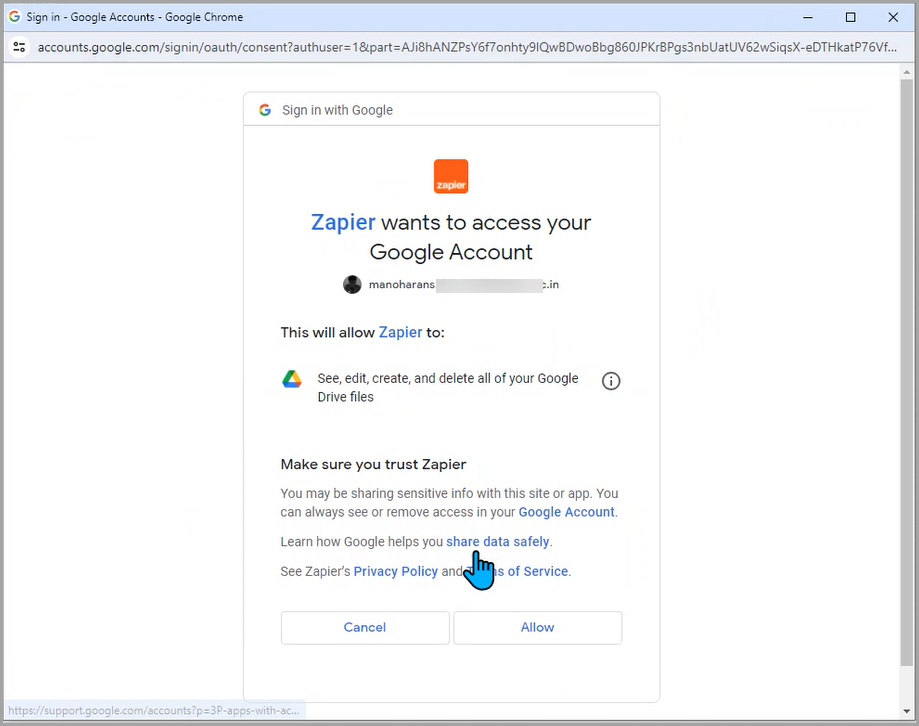
Haga clic en Continuar.

Busca la lista de carpetas recuperadas de tu cuenta de Google Drive conectada.
Elija la carpeta deseada y haga clic en Continuar.
Zapier ejecuta una prueba para asegurarse de que el desencadenador está configurado correctamente.
Crea un documento de Google dentro de la carpeta seleccionada y prueba el activador.
Paso 2: Conectar Document360
En el campo Acción , elija Document360.
En el panel Configuración que aparece a la derecha, seleccione el evento deseado en el campo Evento .
Haga clic en el campo Cuenta y aparecerá un panel de inicio de sesión .
Introduzca sus credenciales de inicio de sesión y haga clic en Permitir.
Para generar el token de API desde el portal de Document360,
Vaya a Configuración () en la barra de navegación izquierda del portal de la base de conocimientos.
En el panel de navegación izquierdo, vaya a Portal de la base de conocimientos > Extensiones > Colaboración en equipo.
En el icono de la extensión Zapier , haga clic en Conectar.
Haga clic en el icono Copiar () para copiar el token.
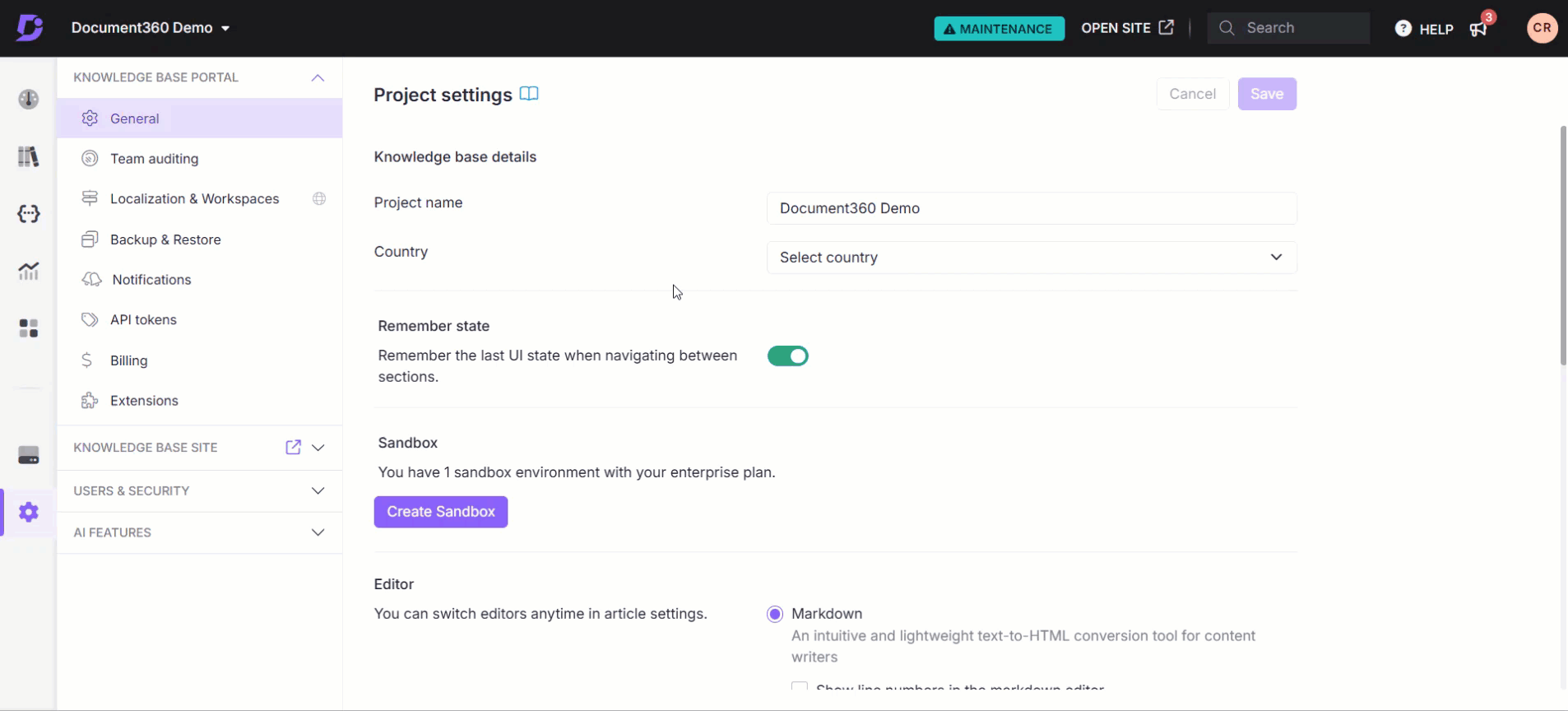
Regresa al panel Zapier y pega el token de API en el campo.
Haga clic en Sí, continuar a Document360.
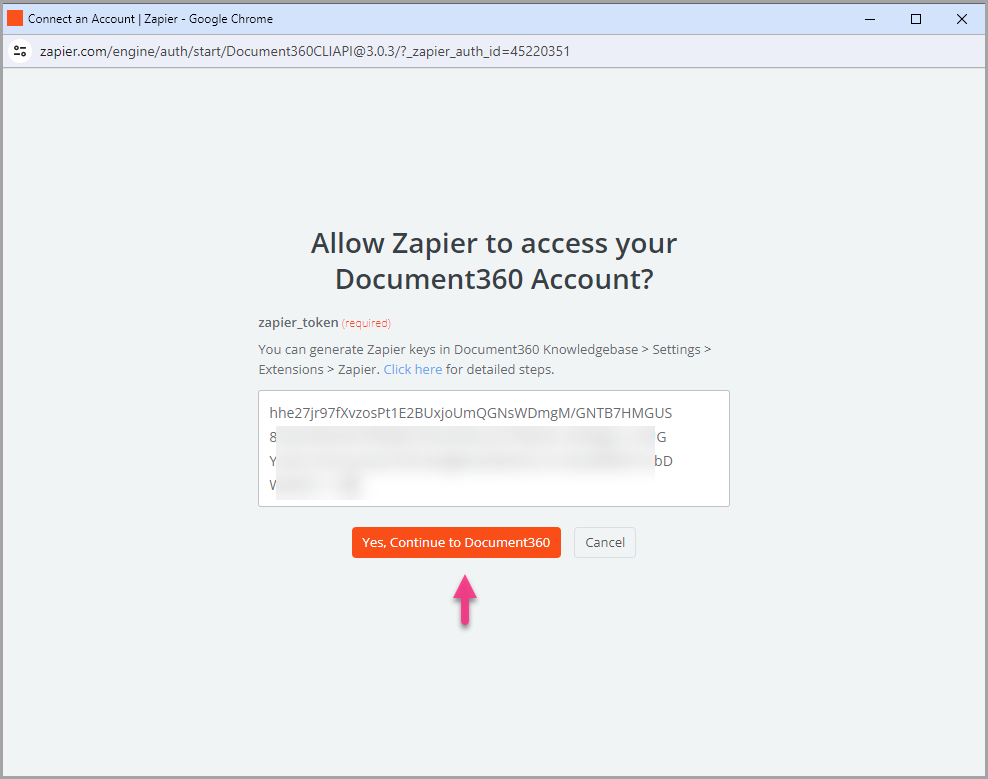
Puede encontrar el proyecto de Document360 conectado en la página Conectar cuenta de Document360 .
Si desea configurar una cuenta diferente más adelante, puede hacerlo haciendo clic en Cambiar.
Haga clic en Continuar.
Paso 3: Personaliza Zap
Asigne los campos de Google Docs a Document360. Asigne todos los campos obligatorios:
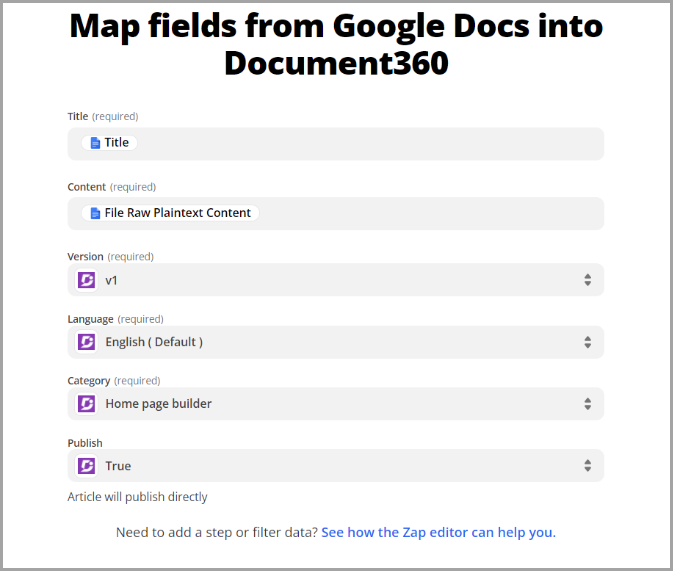
Título: De forma predeterminada, aquí se selecciona el título de Google Docs . Sin embargo, tendrá varias opciones disponibles en función de los requisitos de su negocio.
Contenido: De forma predeterminada, aquí se selecciona el contenido de Google Docs . Sin embargo, tendrá varias opciones disponibles en función de los requisitos de su negocio.
Versión: elija el espacio de trabajo deseado en el proyecto de base de conocimientos donde desea crear el artículo.
Idioma: Elija el idioma deseado en el espacio de trabajo seleccionado en el que desea crear el artículo.
Categoría: Elija la categoría deseada en el idioma seleccionado en el que desea que se cree el artículo.
Publicar: elija Verdadero para el artículo que se va a publicar. Elija Falso para que el artículo esté en estado de borrador.
Una vez hecho esto, haga clic en Continuar.
NOTA
Solo después de asignar todos los campos obligatorios, se habilitará el botón Continuar .
Zap de prueba
En la sección de prueba, haga clic en Paso de prueba.
Si se realiza correctamente, recibirá el mensaje 'Se ha enviado un artículo a Document360'.
En el portal de la base de conocimientos de Document360, encontrará el artículo titulado después del nombre de archivo Google Docs , ubicado en la carpeta que seleccionó anteriormente.
Regresa al panel de configuración Zapier .
Activar Zap
Después de probar el Zap, revise o edite la configuración antes de activarlo.
Puede editar los ajustes configurados en el activador Google Docs y la acción correspondiente del nuevo artículo en Document360.
Recibirás un mensaje de éxito que indica que Your Zap está activado. Puede hacer clic en el botón Administrar su Zap para ir a la página de información general de Google Docs+Document360 Zap.
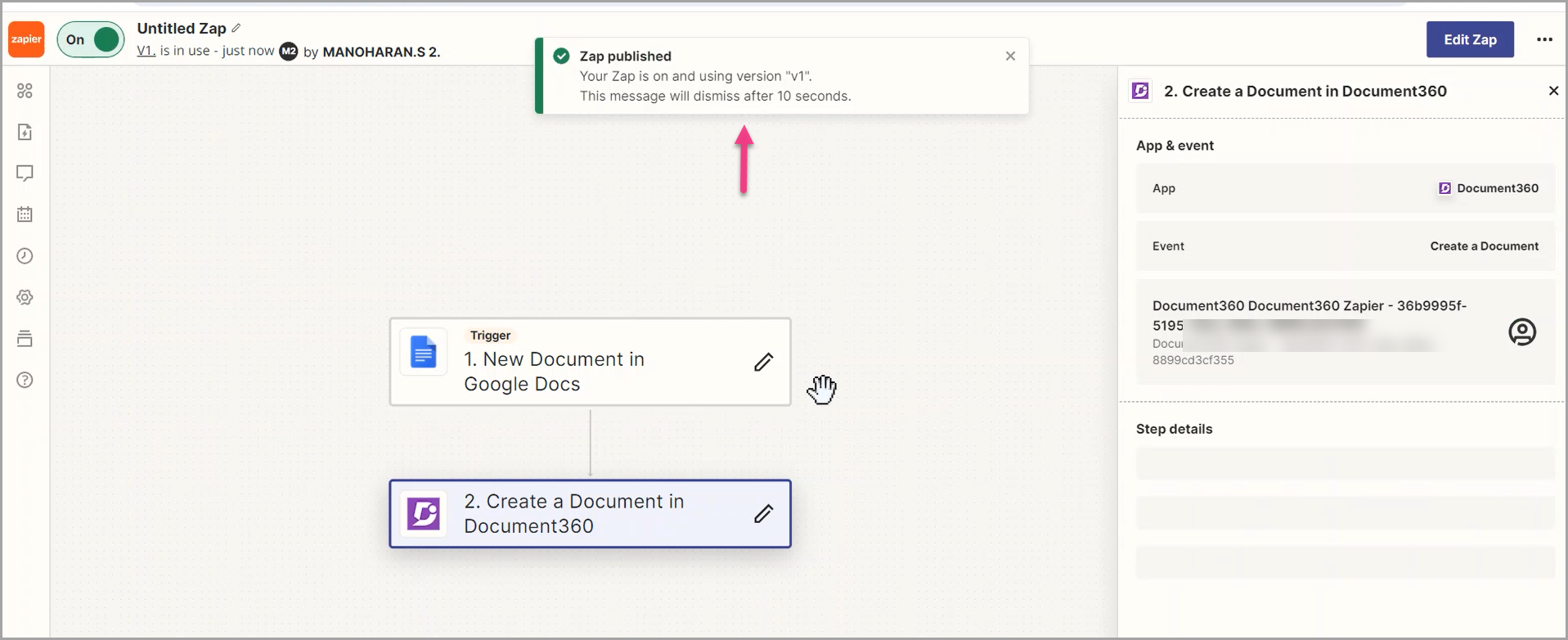
Descripción general de Zap
Crear artículos en Document360 a partir de un nuevo archivo Google Docs
Puede ver y editar la información sobre los Zaps creados en la página de información general de Zap.
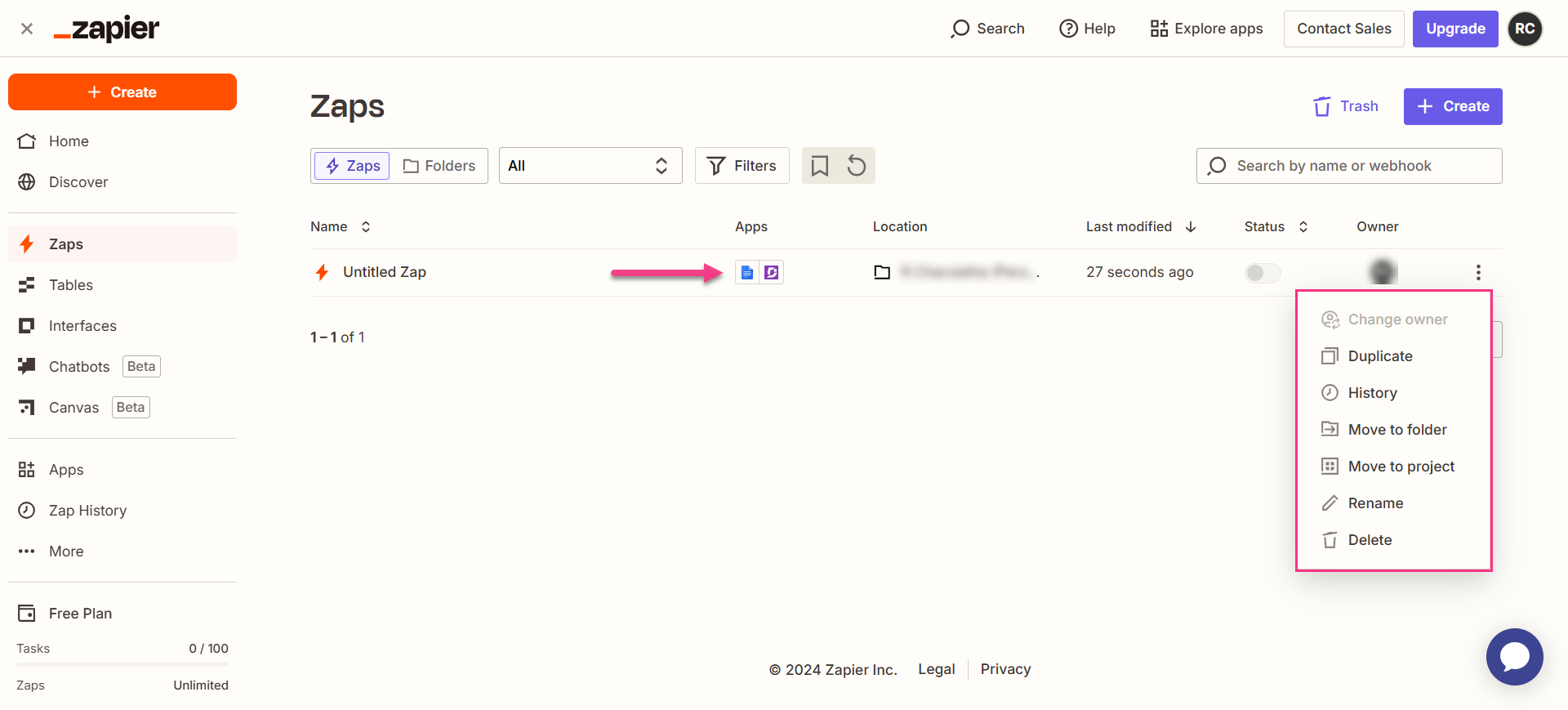
Eliminación de un Zap
Vaya al panel de control de Zapier. En la página de información general, se mostrará una lista de todos los Zaps existentes.
Haga clic en el icono de flecha (>) a la derecha del Zaps deseado y haga clic en Desactivar y eliminar Zap.
El Zap seleccionado se eliminará.